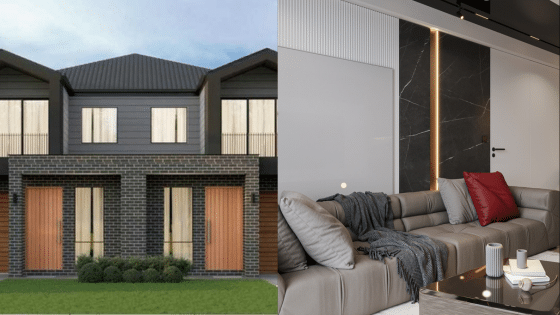
Layering is that secret ingredient of a well-done design. It is what makes a room deep and full of character. It brings that live coziness that you can’t quite pinpoint to a single thing.
However, finding the right balance when it comes to layering can be tricky. Too many layers can result in a cluttered or messy room. Not enough, and it only seems incomplete. That’s why we have curated this guide to help you dress up your place like a professional, beginning from the floor up.
Start with the foundation: The floor layer

It is always a good idea to begin at the bottom: the floors. Whether you’re working with natural solid wood flooring, luxury vinyl tiles, or laminate flooring, you will be able to find something online from stores such as Floors Direct. If you don’t have the luxury of underfloor heating, then don’t forget to add a large rug to warm your feet; it grounds the room, makes it look cozier, and adds more style and character.
When layering on top of hardwood or luxury vinyl tiles, a very soft and textured material can complement it and create contrast. Dark floors and lighter rugs or vice versa will bring depth to the eye without strain.
Do not make the mistake of choosing a rug that is too small for the space. This will only float awkwardly in the middle of the room. A large enough rug will ground your most significant items, such as the sofa, coffee table, or bed.
Want a cheat sheet? Give these combos a go:
- Warm floors, such as dark wood with neutral woven carpeting for a rustic effect
- Light floors with a patterned carpet to maintain a bright space
- LVT plus natural fibers like sisal to create a beach vibe
- Vintage rugs on carpeted rooms to add coziness and personality.
Layer furniture with texture and shape

After grounding your floor, it is time to go up with furniture. This is where the material and shape begin to play a role in the feeling of the room. Rather than purchasing all of the items in a matching set, do the opposite.
For instance, put together a velvet-upholstered sofa with a metal side table. Or perhaps a wooden coffee table with a rattan-woven accent chair. The juxtaposition makes it interesting and breaks the monotony.
Consider form, as well: An oval coffee table may balance the hard angles of a rectangular rug or a square sofa. And here is another insight: do not cram everything against the walls. Allow a breath of space between objects, and your space will feel that much more curated and less cluttered.
Add the soft stuff: pillows, throws & curtains


And here is the snug bit of it, texture. This is the point where you can really put your personality to use. But more is not always better.
It is easy to splurge on throw pillows and blankets, but be thoughtful about it. Try to have 2 or 3 textures, such as velvet, linen, and a chunky knit. Then repeat them in several other areas to connect the space. In addition, avoid stacking the same-sized and shaped pillows. Experiment with varying sizes and shapes and create some depth.
And don’t overlook your windows. Floor-to-ceiling drapes are not just about keeping light out of a room; they lengthen the eye, giving a room a more spacious appearance and that desirable wrapping feel without making a room feel crowded.
Layer the walls—artfully

Walls are mostly underrated, or rather, on the other side, heavily exaggerated. The trick is to make them an ornament of the total layering process. To use them as an eye catcher, but not as a dump where you hang all the old frames that you’ve ever had.
One big work of art can make a much stronger statement than a dozen small ones. This is unless you are creating a carefully curated gallery wall. Another smart touch is mirrors. They deflect light and make the room appear more open and airy.
Moreover, use shelves as tools of vertical layering. Add books and a couple of vases, perhaps a trailing plant, but don’t make every surface full. The small negative space helps distinguish between each object and prevents the space from appearing claustrophobic.
Don’t forget the light layer

Lighting has the power to alter the mood of a room, but it often receives little consideration. The pros understand, though: Lighting, like everything else, needs to be layered.
Begin with a middle ground central overhead light to produce general light, and then introduce task lights, such as a floor or desk lamp, where you need concentrated light. Lastly, put some finishing touches, such as ambiance candles, sconces, or a daisy chain of a low-wattage table lamp, to finish it off.
The key is to position the light sources at various heights so as to create a soft composition of shades as well as illumination that gives the area depth. And never underestimate style, something as large as an oversized floor lamp can play the role of a sculpture, particularly in a less dense space.
Style the surface layer (carefully)

Now you are at the nitty-gritty stage. The stuff that makes your space have soul. Imagine coffee tables, nightstands, consoles, and counters. You might want to stuff them with all of your favorite things, but moderation is important.
Firstly, cluster in odd numbers. Three or five is visually a sweet spot, and mix height and texture to make it interesting. A book, a few books, and a small serving dish, say, can give the impression of layers without the impression of clutter.
Don’t forget to leave negative space as well. Surfaces do not have to be full to make them feel stylish. Also, add one organic touch, such as a plant with leaves or a driftwood, to give life to the room.
Bonus tip


Editing is relevant in home decoration. Stand back and assess the space. You might find that something does not add any value or breaks the flow. In that case, remove it to create space and ensure that the rest of the area shines through.
Closing thoughts
A well-layered room does not feel crowded. It feels inhabited and harmonious. Whether you are redecorating an entire room or merely refreshing it, layering strategically, starting with the floor, will make everything seem more cohesive, organized, and personal.
- 0shares
- Facebook0
- Pinterest0
- Twitter0
- Reddit0













